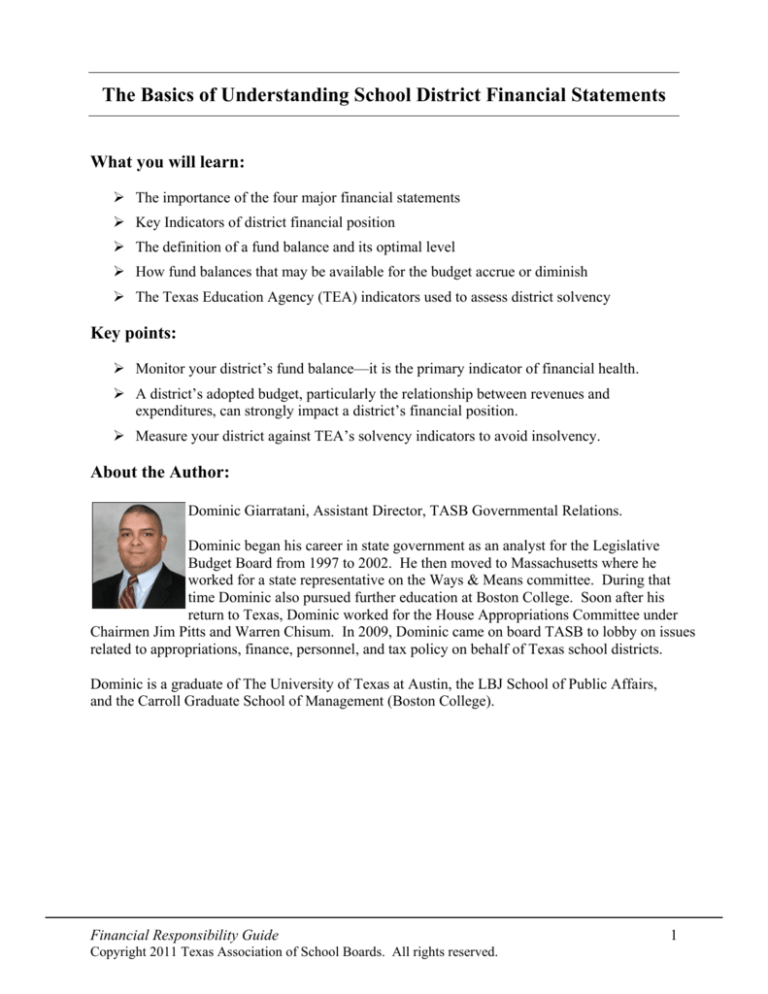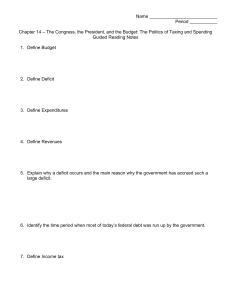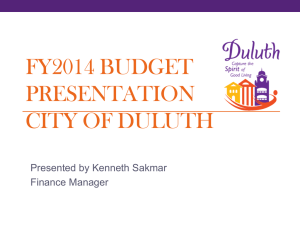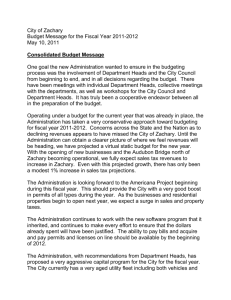
The Basics of Understanding School District Financial Statements
What you will learn:
The importance of the four major financial statements
Key Indicators of district financial position
The definition of a fund balance and its optimal level
How fund balances that may be available for the budget accrue or diminish
The Texas Education Agency (TEA) indicators used to assess district solvency
Key points:
Monitor your district’s fund balance—it is the primary indicator of financial health.
A district’s adopted budget, particularly the relationship between revenues and
expenditures, can strongly impact a district’s financial position.
Measure your district against TEA’s solvency indicators to avoid insolvency.
About the Author:
Dominic Giarratani, Assistant Director, TASB Governmental Relations.
Dominic began his career in state government as an analyst for the Legislative
Budget Board from 1997 to 2002. He then moved to Massachusetts where he
worked for a state representative on the Ways & Means committee. During that
time Dominic also pursued further education at Boston College. Soon after his
return to Texas, Dominic worked for the House Appropriations Committee under
Chairmen Jim Pitts and Warren Chisum. In 2009, Dominic came on board TASB to lobby on issues
related to appropriations, finance, personnel, and tax policy on behalf of Texas school districts.
Dominic is a graduate of The University of Texas at Austin, the LBJ School of Public Affairs,
and the Carroll Graduate School of Management (Boston College).
Financial Responsibility Guide
Copyright 2011 Texas Association of School Boards. All rights reserved.
1
The Basics of Understanding School District Financial Statements
Introduction
School boards, as the governing bodies of school districts, are responsible for overseeing, among
other things, district financial management. As school board trustees come to the table from
various walks of life and diverse backgrounds, understanding and assessing the district’s
financial condition will be more challenging for some than others. The goal of this section of the
Guide is to provide a basic understanding of the type of financial statements you will have access
to as a trustee, as well as the key information within these statements that are indicators of a
district’s financial position.
Major Financial Statements
Every school district, by law, is required to have district accounts audited annually at the close of
the fiscal year. The audit is performed on the record of the accounts as maintained by the school
district’s treasurer. In some instances, the results of this audit, including numerous district
financial statements, will be reported in a district’s “Comprehensive Annual Financial Report,”
commonly known as the “CAFR.” While all of the information is informative, there are four
statements that are particularly important in assessing the district’s financial position.
Depending on the size and capability of your district’s finance department, you may have access
to unaudited statements over the course of your fiscal year. These statements are:
Statement of Net Assets;
Statement of Activities;
Balance Sheet; and
Statement of Revenues, Expenditures, and Changes in Fund Balance.
The Statement of Net Assets and the Statement of Activities are government-wide financial
statements that provide both long-term and short-term information about the district’s overall
financial status. While these statements contain summary data for the district itself, they also
include data for any legally separate entities for which the district is accountable. In contrast to the
government-wide financial statements, the Balance Sheet and the Statement of Revenues,
Expenditures, and Changes in Fund Balance, are fund financial statements that focus on discrete
parts of a district’s activities as segregated through the use of a fund account (“fund”).1 The purpose
of fund financial statements is to describe how the services provided through each fund were
financed in the short-term, and what remains available for future spending. Thus, these statements
exclude some financial data that will be found in government-wide statements, as discussed below.
Financial Responsibility Guide
Copyright 2011 Texas Association of School Boards. All rights reserved.
2
The Statement of Net Assets and the Balance Sheet
The statement of net assets and the balance sheet provide financial information on the district as a
whole, and on a particular fund respectively. They are similar in that both statements detail this
information in terms of assets, liabilities, and an ending balance. Assets are economic resources,
tangible or intangible, that are owned or controlled by the district and that can be converted into
cash. District assets include cash and investments, but also include things such as land, buildings,
and vehicles. Liabilities are obligations of the district, arising from past transactions or events, the
settlement of which may result in the transfer or use of assets. Some of the more common
liabilities include interest payable on bonds, accrued salaries, and accounts payable.
Net assets are the district’s liabilities subtracted from its assets; it represents what the district
would retain if all of its financial obligations were satisfied. Or, to put it another way, if a
district were developing a plan to cease operations, the net assets are what the district would
expect to return to the taxpayers or transfer to a successor entity. The fund balance is what
remains in a particular fund at the end of the fiscal year that a school board may use in
subsequent fiscal years to pay for activities for which the fund was created.
In addition to describing a fund’s financial position, rather than the financial position of the
district as a whole, balance sheets differ from a statement of net assets in one crucial respect—a
focus on the short-term. This means that the balance sheet contains information only on current
assets and liabilities.2 Finally, a balance sheet will provide detail on restrictions or commitments
related to the fund balance.
Financial Indicator # 1: Over time, increases or decreases in net assets may serve as a
useful indicator of whether the district’s financial position is improving or deteriorating.
Financial Indicator #2: Accumulated depreciation is a contra-asset found on the statement
of net assets that is used to write down the value of an asset as it is consumed due to usage or
age. The higher the amount of accumulated depreciation compared to the value of a district’s
capital assets (buildings and improvements, vehicles, etc.), the more likely the district will
need to make significant purchases in that area.
Financial Indicator #3: Beginning with the fiscal year ending in 2011, fund balances must
be characterized as nonspendable, restricted, committed, assigned, and unassigned. Prior to
the fiscal year ending in 2011, unassigned fund balances were referred to as unreserved,
undesignated fund balances. These fund balances are available for future use at the
discretion of the school board. TEA has published a rule of thumb for the General Fund’s
optimum unreserved, undesignated fund balance as “equal to the estimated amount needed to
cover cash flow deficits in the fall period in the following fiscal year plus estimated average
monthly cash disbursements of the General Fund for the following fiscal year.”3 The
district’s administration should be able to report if this standard is being met.
Financial Responsibility Guide
Copyright 2011 Texas Association of School Boards. All rights reserved.
3
The Statement of Activities and the Statement of Revenues, Expenditures, and
Changes in Fund Balance
The Statement of Activities and the Statement of Revenues, Expenditures, and Changes in Fund
Balance provide financial information on the district as a whole, and on particular funds
respectively. They are similar in that both statements detail this information in terms of
revenues, expenditures, and net assets or fund balance.
Revenues represent a school district’s gross receipts. These receipts include local property taxes,
state aid, federal funds, donations, and investment earnings. In short, revenues are all income
received by the school district in the form of cash or its equivalent. Expenditures are financial
outlays allocated to a specific function or program which is charged against revenue. School
districts have expenditures related to providing an educational program such as instruction,
school leadership, and transportation. Additionally, many districts have expenditures related to
servicing debt and acquiring capital items.
As with the Balance Sheet, the Statement of Revenues, Expenditures and Changes in Fund
Balance focuses on revenues and expenditures made in the short-term. It will not contain
information on revenue or expenditures that are expected to be realized outside of one year, such
as uncollected taxes or earned, but unused vacation leave.
Financial Indicator #4: The statement of revenues, expenditures, and changes in fund
balance will have a subtotal line titled “Excess (deficiency) of revenues over (under)
expenditures.” When revenues exceed expenditures, a surplus is created which adds to net
assets/fund balances, and may be used by trustees in subsequent fiscal years. When
expenditures exceed revenues the result is a deficit. Deficits may be met by using fund
balances, borrowing, or transfers from other funds. Over time, if deficits persist, the district
may need to enhance revenues through tax increases or other means, or reduce expenditures
through program or service cuts, debt refinancing, or other means.
The District’s Budget
As a school board trustee, you are tasked with managing the school district’s finances through
the adoption of a budget. The financial statements that have been discussed present a picture of
actual financial data at the end of a fiscal year. In fact, you may already be aware of the
similarities between the statement of revenues, expenditures, and changes in fund balance, and
your district’s budget summary. The former document details how the budget impacted the
district’s financial condition during the last fiscal year, while the latter document captures the
financial impact of district operations over the next fiscal year. For this reason, the financial
indicators, such as revenues compared to expenditures, remain applicable when analyzing the
district’s proposed budget.
Financial Responsibility Guide
Copyright 2011 Texas Association of School Boards. All rights reserved.
4
Of course, the most important part of adopting a budget is allocating the district’s resources in a
manner that reflects the board’s stated vision and priorities. However, from a financial
stewardship perspective, the most important part of budget adoption process is whether the budget
positions the district to continue as an ongoing entity well into the future. There are numerous
financial indicators that can be gleaned from budget documents about a district’s financial
viability, but the following three should assist a trustee in beginning to make this determination.
Financial Indicator #5: If the proposed budget uses fund balances, how many years can the
district continue operating at the same program levels while using the same amount of fund
balances before fund balances have been exhausted. If the answer is less than three years, the
district may not have the opportunity to seek additional state aid and may be forced into
severe program cuts or tax increases.
Financial Indicator #6: Are property values rising or falling in your district and in the
Austin Independent School District (AISD)? Districts are exempt from recapture on the first
six pennies (“golden pennies”) levied above the compressed tax rate. If property values fall,
the district will receive less revenue. AISD has estimated that its taxable value will decline
by 5.7% for fiscal year 2011, even as district enrollment is increasing. Property-poor
districts are guaranteed a yield at AISD’s level, which will result in a reduced golden penny
yield for these districts if Austin property values do not increase.
Financial Indicator #7: Are items and programs funded with American Recovery and
Reinvestment Act funds (i.e., stimulus funds) things the district can forgo? Stimulus funds
were sent to the states and school districts as an extraordinary federal expenditure that would
not be continued into the future. If stimulus funds were used for one-time investments, like
to fund capital purchases or provide special programming, the district is better positioned
when stimulus funds end. If, however, stimulus funds paid for salaries or programs which
local citizens expect to continue, the board may find its hands tied when trying to make
prudent financial decisions on behalf of the district.
Texas Education Agency’s Financial Solvency Review
In 2009, the Texas Legislature passed House Bill 3 which directed the Texas Education Agency
(TEA) to develop a review process to anticipate the future financial solvency of each school
district. TEA has developed a methodology to determine financial solvency, and identified
school districts at risk of financial insolvency for the first time in 2010. The indicators in the
attached table have been identified by the TEA as critical indicators in evaluating school district
solvency. The data needed to test these indicators can be found in a district’s financial
statements or budget documents or may be provided by district administration. If TEA
determines that a district is at risk of financial insolvency, it may require the district to submit a
financial plan for approval. Failure to resolve the situation can earn a district an “AccreditedWarned” status. Consequently, trustees should keep these indicators in mind when analyzing
district financial statements.
Financial Responsibility Guide
Copyright 2011 Texas Association of School Boards. All rights reserved.
5
Conclusion
It can be a daunting task for an individual without an accounting or finance background to look
through financial statements and understand the district’s financial condition. However, it is a
necessary step in becoming informed about the resources the district has at its disposal and the
obligations the district needs to fulfill. With this knowledge, board members will be prepared to
ask the right questions during board meetings and to make informed decisions, particularly
during budget adoption. Understanding the information contained within financial statements is
a key step toward ensuring that your district can continue to provide a quality academic program
for years to come.
This document is provided for educational purposes only and contains information to facilitate a general
understanding of the law. It is neither an exhaustive treatment of the law on this subject nor is it intended to
substitute for the advice of an attorney. It is important for the recipient to consult with the district's own attorney in
order to apply these legal principles to specific fact situations.
Copyright © 2011 Texas Association of School Boards, Inc. All rights reserved.
This document is copyrighted by TASB but may be reproduced in order to share the information within your own
school district. Further use or copying is prohibited without the consent of TASB Legal Services. Requests to
duplicate or distribute this document should be made in writing to Director, Legal Services, Texas Association of
School Boards, P.O. Box 400, Austin, Texas 78767-0400 or by e-mailing legal@tasb.org.
Published February 2011
Financial Responsibility Guide
Copyright 2011 Texas Association of School Boards. All rights reserved.
6
Critical Indicators For School Districts
Student to Staff Ratio Outside the Norm or Declining
WADA-to-all-staff ratio is less than 85% of mean ratio for group
WADA-to-all-staff ratio declined by more than 7% from prior year
Enrollment-to-teacher ratio less than 85% of mean ratio for group
Where to Find Relevant Data
Group mean Ratio provided by TEA.
WADA, Staff, and Enrollment Data
usually found as part of budget
packet.
Determination of
Category Flags
Final
Determination
Any Yes causes a
“Yes” flag for this
category
Enrollment-to-teacher ratio less than 85% of mean ratio for group
Any district with
3 or more flags
General Fund Expenditures Exceeding Revenues
Expenditures exceed revenues by more than 6%
If expenditures exceed revenues by more than 4% and exceeded
revenues by more than 3% in the prior year
If expenditures exceed revenues by any amount and the district has a
prior year end-of-year fund balance that has declined from the year
before and that is less than 4% of the general fund expenditures
Actual Expenditures Consistently Exceeding Budgeted Expenditures
(Inability to Stay Within Budget)
Actual expenditures exceeded budgeted expenditures by more than
10% in the prior year
Actual expenditures exceeded budgeted expenditures by more than
6% in the prior year and actual expenditures exceeded budgeted
expenditures by more than 4% two years prior
Declining or Low General Fund Unreserved Fund Balance
The prior year end-of-year fund balance has declined from the year
before and the fund balance is less than 6.25% of the district’s
General fund expenditures
The prior year end-of-year fund balance has declined from the year
before by more than 25% and the fund balance is less than 12.5% (1
and a half months) of the district's general fund expenditures
The prior year end-of-year fund balance is less than 1% of the
district’s general fund expenditures
For current year data, review budget
documents. For the prior year look at
the statement of revenues,
expenditures, and changes in fund
balances.
Compare expenditures in the prior
year or two using the applicable
year’s statement of revenues,
expenditures and applicable year’s
adopted budget.
Compare fund beginning and ending
fund balances from the Statement of
Revenues, Expenditures and Changes
in Fund Balance and budget
documents. Compare ending fund
balances to current year adopted
budget expenditures.
Financial Responsibility Guide
Copyright 2011 Texas Association of School Boards. All rights reserved.
Any Yes causes a
“Yes” flag for this
category
Any Yes causes a
“Yes” flag for this
category
Any district with
2 or more flags
and a fund
balance less than
2 months general
fund expenditures
Any district with
the fund balance
flag and one
other flag
Any district with
a fund balance
less than 1% of
general fund
expenditures
Any Yes causes a
“Yes” flag for this
category
7
1
2
3
Texas school districts typically have up to four types of governmental fund accounts. These accounts, called Major Accounts, are the General Fund (to
account for the daily operation of school districts), Special Revenue Funds (to account for revenue sources with legal restrictions on expenditures), Debt
Service Fund (to account for principal and interest accounting on debt paid with a dedicated tax), and Capital Project Fund (to account for projects finance
with bond proceeds). In addition to the aforementioned “governmental funds”, districts may also have proprietary funds, including internal service and
enterprise funds, to account for operations related to food service, Medicaid or other programs, and fiduciary funds, which account for assets held by the
district as trustee or as an agent of another organization.
Current assets are cash or assets that can be converted into cash within one year. In contrast noncurrent assets are assets that generally take longer than one
year to convert to cash. Examples of noncurrent assets include vehicles, buildings, or a two-year certificate of deposit. Similarly, current liabilities are
obligations that the district is required to or expects to pay off within one year. An example of a current liability is interest payments owed on a bond over a
one year payment. A noncurrent or long term liability would be the interest payments owed over the life-time of a bond outside of the one-year period.
Financial Accountability System Resource Guide, Module 1. Financial Accounting and Reporting, Update 14, January 2010, available at
www.tea.state.tx.us/index4.aspx?id=1222, pp. 143-144.
Financial Responsibility Guide
Copyright 2011 Texas Association of School Boards. All rights reserved.
8








